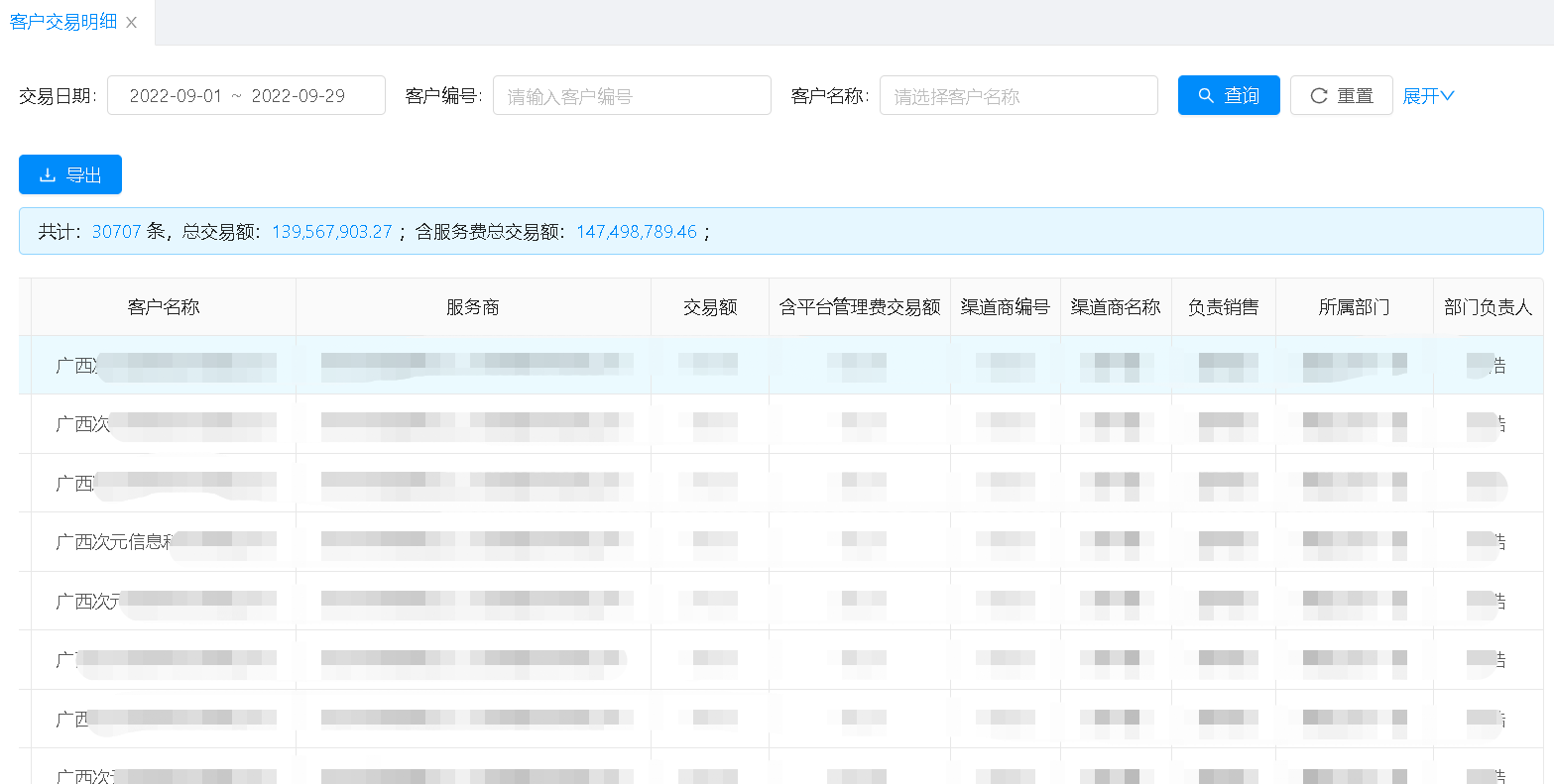不扒瞎,这个程序让我从300s优化到了10s
前天晚上加班完成部门Q4KPI考核计划后,看到业务开发组的几个小伙伴在处理生产问题。我上前了解情况。
销管系统,客户交易明细页面,查询客户交易数据的逻辑是:调用远程数据中心接口,拿到原始交易数据集合,然后在内存里通过相关id来给客户名称、服务商名称、销售人员名称、所属部门、上级销售主管赋值。

产品经理反馈,销售主管登陆系统查询数据时,非常慢,慢到4~5分钟。
查看日志,发现后台程序处理耗时动辄高达300s。
300s是个庞大的数字!当务之急,是看能不能降低到10s以内。通过分析,其中,获取远程交易数据耗时≈6s,本地内存数据匹配竟然耗时200多秒,incredible!unbelievable!

那接下来要对各个匹配数据的程序段来分析。通过细化耗时,发现在for循环匹配销售数据为销售人员名称、所属部门、上级销售主管赋值时,异常地慢。
贴出来这段代码:
/** * 查询销售与部门的关联关系 * @param saleId * @return */public CommonRequestDTO selectSaleDepartRelation(Integer saleId){ List<CommonRequestDTO> relationList = CacheUtil.getCache(SaleCommonConstant.SALE_DEPART_RELATION, SaleCommonConstant.EXPIRY_SECONDS, () -> emaxSalerMapper.selectSaleDepartRelation() ); relationList = relationList.stream().filter(o -> saleId.equals(o.getSaleId())).collect(Collectors.toList()); if(CollectionUtils.isNotEmpty(relationList)){ CommonRequestDTO commonRequestDTO = relationList.get(0); commonRequestDTO.setSaleName(commonRequestDTO.getSaleName()); commonRequestDTO.setDepartName(commonRequestDTO.getDepartName()); commonRequestDTO.setDepartHeaderName(commonRequestDTO.getDepartHeaderName()); return commonRequestDTO; } return null;} |
其中,CacheUtil封装了Redis的get/set操作。
emaxSalerMapper#selectSaleDepartRelation是查数据库获取基础关系数据,共223条数据,耗时6~7ms。
CommonRequestDTO是一个pojo模型类。
那么,这段代码也看不出哪里慢呀!
仔细一分析,发现端倪。Cc同学怀疑问题出在读redis上。果不其然,for循环里频繁调用redis获取集合数据,尤其是当查询数据记录多循环次数多时,必然拉跨。
当务之急,最好的解决办法,是用本地缓存来搞,HutoolCache登场。
static TimedCache<String ,List<CommonRequestDTO>> cache= cn.hutool.cache.CacheUtil.newTimedCache(SaleCommonConstant.EXPIRY_SECONDS);/** * 查询销售与部门的关联关系 * @param saleId * @return */public CommonRequestDTO selectSaleDepartRelation(Integer saleId){ if (cache.get(SaleCommonConstant.SALE_DEPART_RELATION)==null){ cache.put(SaleCommonConstant.SALE_DEPART_RELATION, emaxSalerMapper.selectSaleDepartRelation()); } List<CommonRequestDTO> relationList = cache.get(SaleCommonConstant.SALE_DEPART_RELATION); relationList = relationList.stream().filter(o -> saleId.equals(o.getSaleId())).collect(Collectors.toList()); if(CollectionUtils.isNotEmpty(relationList)){ CommonRequestDTO commonRequestDTO = relationList.get(0); commonRequestDTO.setSaleName(commonRequestDTO.getSaleName()); commonRequestDTO.setDepartName(commonRequestDTO.getDepartName()); commonRequestDTO.setDepartHeaderName(commonRequestDTO.getDepartHeaderName()); return commonRequestDTO; } return null;} |
改造完成,再测试,发现这段代码耗时已经到ms级了。整体方法耗时也控制在了10s以内。
那么,回过头来分析,我们看程序里redis-RedisTemplate配置,valueSerializer使用Jackson2JsonRedisSerializer,Jackson2JsonRedisSerializer序列化使用ObjectMapper。
/** * RedisTemplate配置 * @param lettuceConnectionFactory * @return */@Beanpublic RedisTemplate<String, Object> redisTemplate(LettuceConnectionFactory lettuceConnectionFactory) { // 设置序列化 Jackson2JsonRedisSerializer<Object> jackson2JsonRedisSerializer = new Jackson2JsonRedisSerializer<Object>(Object.class); ObjectMapper om = new ObjectMapper(); om.setVisibility(PropertyAccessor.ALL, Visibility.ANY); om.enableDefaultTyping(DefaultTyping.NON_FINAL); jackson2JsonRedisSerializer.setObjectMapper(om); // 配置redisTemplate RedisTemplate<String, Object> redisTemplate = new RedisTemplate<String, Object>(); redisTemplate.setConnectionFactory(lettuceConnectionFactory); RedisSerializer<?> stringSerializer = new StringRedisSerializer(); redisTemplate.setKeySerializer(stringSerializer);// key序列化 redisTemplate.setValueSerializer(jackson2JsonRedisSerializer);// value序列化 redisTemplate.afterPropertiesSet(); return redisTemplate;} |
ObjectMapper在序列化时,会将所有的字段序列化,无论这些字段是否有值(是否为null)。再看CommonRequestDTO,有多达22个属性,可见在本案List<CommonRequestDTO>中有223个元素时,数据体积无形中增大很多。通过下面对ObjectMapper的测试代码来比较一下,很明显可以看到单个对象序列化后在数据量方面的差异:
@Testpublic void testObjectMapper2() throws JsonProcessingException { ObjectMapper om = new ObjectMapper(); om.setVisibility(PropertyAccessor.GETTER, JsonAutoDetect.Visibility.PUBLIC_ONLY) .enableDefaultTyping(ObjectMapper.DefaultTyping.NON_FINAL); System.out.println("序列化所有字段(无论这些字段是否有值) ↓ ↓ ↓"); System.out.println(new String(om.writeValueAsBytes(new CommonRequestDTO()))); om = new ObjectMapper(); om.setVisibility(PropertyAccessor.GETTER, JsonAutoDetect.Visibility.PUBLIC_ONLY) .enableDefaultTyping(ObjectMapper.DefaultTyping.NON_FINAL) .setSerializationInclusion(JsonInclude.Include.NON_NULL); System.out.println("不序列化空值字段 ↓ ↓ ↓"); System.out.println(new String(om.writeValueAsBytes(new CommonRequestDTO())));} |
序列化所有字段(无论这些字段是否有值) ↓ ↓ ↓["com.emax.memberaccount.restapi.vo.CommonRequestDTO",{"enterpriseId":null,"enterpriseBizId":null,"enterpriseName":null,"saleId":null,"product":null,"entStatus":null,"departId":null,"agentId":null,"levyId":null,"departHeaderId":null,"saleIds":null,"enterpriseIds":null,"productList":null,"createTimeBegin":null,"createTimeEnd":null,"saleName":null,"departName":null,"departHeaderName":null,"ifDepartHeader":null,"loginSalerId":null,"selectEnterpriseId":null,"orderEndTime":null,"enterpriseProductDTOS":null}]不序列化空值字段 ↓ ↓ ↓["com.emax.memberaccount.restapi.vo.CommonRequestDTO",{}] |
- 因此,我们的程序有必要加上这个控制,即只序列化非空字段。
另外,就像我之前经常提到的,会 is one thing,会用 is another。本案也再一次敲响了警钟:在使用redis分布式缓存时,尤其控制缓存大对象,更要严禁高频访问大对象缓存。
相关文章
- 金融服务领域的大数据:即时分析
- 影响大数据、机器学习和人工智能未来发展的8个因素
- 从0开始构建一个属于你自己的PHP框架
- 如何将Hadoop集成到工作流程中?这6个优秀实践必看
- SEO公司使用大数据优化其模型的5种方法
- 关于Web Workers你需要了解的七件事
- 深入理解HTTPS原理、过程与实践
- 增强分析:数据和分析的未来
- PHP协程实现过程详解
- AI专家:大数据知识图谱——实战经验总结
- 关于PHP的错误机制总结
- 利用数据分析量化协同过滤算法的两大常见难题
- 怎么做大数据工作流调度系统?大厂架构师一语点破!
- 2019大数据处理必备的十大工具,从Linux到架构师必修
- OpenCV中的KMeans算法介绍与应用
- 教大家如果搭建一套phpstorm+wamp+xdebug调试PHP的环境
- CentOS下三种PHP拓展安装方法
- Go语言HTTP Server源码分析
- Go语言HTTP Server源码分析
- 2017年4月编程语言排行榜:Hack首次进入前五十

